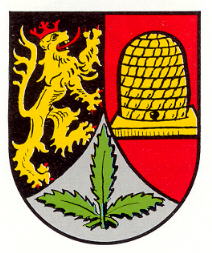Gräfenhausen (Annweiler am Trifels): Difference between revisions
Knorrepoes (talk | contribs) m (Text replacement - "'''↵| ↵|-↵|'''English''' ↵| {{blazon wanted}}↵|}" to "''' | blazon wanted |- |'''English''' | blazon wanted |}") |
Knorrepoes (talk | contribs) m (Text replacement - "{{media}}" to " {{de1}} {{media1}}") |
||
| Line 26: | Line 26: | ||
Hupp mentioned for Gräfenhausen totally different arms based on an 18<sup>th</sup> century seal, which actually belonged to [[Grevenhausen]]. | Hupp mentioned for Gräfenhausen totally different arms based on an 18<sup>th</sup> century seal, which actually belonged to [[Grevenhausen]]. | ||
{{ | |||
{{de1}} | |||
{{media1}} | |||
[[Civic Heraldry Literature - Germany|'''Literature''']]: Debus, 1988 | [[Civic Heraldry Literature - Germany|'''Literature''']]: Debus, 1988 | ||
Revision as of 11:34, 26 December 2022
This page is part of the German heraldry portal Deutsche Wappensammlung |
Heraldry of the World |
|
German heraldry:
|
Selected collector's items from Germany:
|
GRÄFENHAUSEN
State : Rheinland-Pfalz
District (Kreis) : Südliche Weinstrasse
Incorporated into : 1979 Annweiler am Trifels
| German | blazon wanted |
| English | blazon wanted |
Origin/meaning
The arms were granted on December 15, 1951.
The village became in medieval times a possession of the Eusserthal Abbey and later came into possession of the Dukes of the Pfalz-Zweibrücken. This is symbolized by the upper half of the arms, showing the lion of the Pfalz and the beehive, attribute of St. Bernardus of Clairvaux, patron saint of the Abbey. The base shows a chestnut leaf, symbol for the forests in the region. The three leaves symbolize the (former) villages of Gräfenhausen, Mettenbach and Rodenbach.
Hupp mentioned for Gräfenhausen totally different arms based on an 18th century seal, which actually belonged to Grevenhausen.
Literature: Debus, 1988


